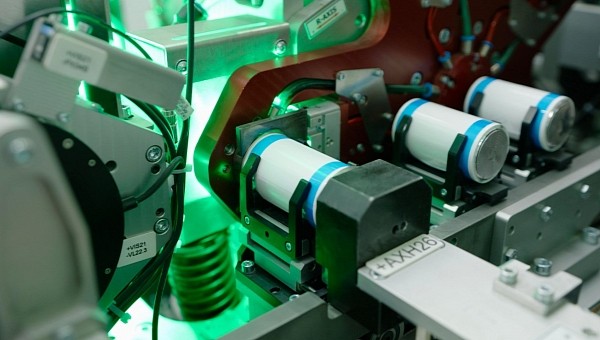Tesla is working hard on a dry battery electrode manufacturing process, but the progress is slow to materialize. Nevertheless, a series of patents filed with the USPTO hint at a breakthrough in this field. If this is indeed the case, Tesla might be able to manufacture batteries at half the cost that can endure a lot more charge-discharge cycles than current Li-ion batteries.
One of Tesla’s promises at Battery Day in 2020 was a novel battery manufacturing process that would drastically improve battery performance and cost structure. Tesla said the 4680 batteries would feature a silicon anode instead of graphite and a new dry cathode manufacturing process that could cut production costs in half while at the same time extending the battery life cycle.
The dry cathode manufacturing process is considered the holy grail of Li-Ion batteries and is the main reason Tesla bought Maxwell in 2019. Maxwell used this technology to manufacture supercapacitors, but Tesla thought it could transplant it into its battery manufacturing process. Two years later, Tesla sold the ultracapacitor business it acquired with Maxwell but kept the dry battery electrode (DBE) tech for itself. The 4680 cells were meant to be the debut vehicle for the new technology, although this didn’t happen.
“Dry electrode is a key piece (one of many pieces) of the puzzle for lowering cost of lithium batteries,” tweeted Musk in July 2021. “That said, it has required an *immense* amount of engineering to take Maxwell’s proof-of-concept to high-quality, volume production & we’re still not quite done.”
Well, Tesla is still not quite done today either, although several recent patents granted to Tesla might indicate it is getting closer than ever. In January, we found out about two patent filings pertaining to the DBE technology. One is related to dry electrode films and microparticulate non-fibrillizable binders, which improve battery lifecycle. The second refers to new electrode binders that can withstand higher operating voltages without undergoing a rapid degradation process.
On February 2, the USPTO published two more patent applications that Tesla filed related to the DBE technology. The first is for “Elemental metal and carbon mixtures for energy storage devices” and includes a dry electrode film. The film comprises the elemental lithium metal and carbon particles, porous carbon particles, and a solid electrolyte interface(SEI) layer covering exposed portions of the elemental lithium metal.
Recently, we learned that Tesla installed two gigantic presses in the battery manufacturing section at Giga Austin. According to people with knowledge of the matter, the Sacmi Imola presses were roughly three times bigger than what Tesla would have needed for raw material pressing. This, and the upcoming battery production line at the Nevada gigafactory, indicate that Tesla is preparing to significantly ramp up the 4680 cell production. If that’s the case, Tesla probably overcame the DBE technology hurdles, and we’re in for a technological breakthrough in Li-Ion batteries.
The dry cathode manufacturing process is considered the holy grail of Li-Ion batteries and is the main reason Tesla bought Maxwell in 2019. Maxwell used this technology to manufacture supercapacitors, but Tesla thought it could transplant it into its battery manufacturing process. Two years later, Tesla sold the ultracapacitor business it acquired with Maxwell but kept the dry battery electrode (DBE) tech for itself. The 4680 cells were meant to be the debut vehicle for the new technology, although this didn’t happen.
“Dry electrode is a key piece (one of many pieces) of the puzzle for lowering cost of lithium batteries,” tweeted Musk in July 2021. “That said, it has required an *immense* amount of engineering to take Maxwell’s proof-of-concept to high-quality, volume production & we’re still not quite done.”
Well, Tesla is still not quite done today either, although several recent patents granted to Tesla might indicate it is getting closer than ever. In January, we found out about two patent filings pertaining to the DBE technology. One is related to dry electrode films and microparticulate non-fibrillizable binders, which improve battery lifecycle. The second refers to new electrode binders that can withstand higher operating voltages without undergoing a rapid degradation process.
On February 2, the USPTO published two more patent applications that Tesla filed related to the DBE technology. The first is for “Elemental metal and carbon mixtures for energy storage devices” and includes a dry electrode film. The film comprises the elemental lithium metal and carbon particles, porous carbon particles, and a solid electrolyte interface(SEI) layer covering exposed portions of the elemental lithium metal.
Electrolytes for extending Li-Ion battery cell lifetime
The second patent application is for a more convenient method for the preparation of 3-R-1,4,2-dioxazol-5-one compounds. The complicated name designates an electrolyte additive that has been shown to significantly extend the lifetime of lithium-ion cells during prolonged cycling. The patent applications were filed quite recently, in June and August 2022, respectively, indicating that the EV maker continues to innovate in battery technology.Recently, we learned that Tesla installed two gigantic presses in the battery manufacturing section at Giga Austin. According to people with knowledge of the matter, the Sacmi Imola presses were roughly three times bigger than what Tesla would have needed for raw material pressing. This, and the upcoming battery production line at the Nevada gigafactory, indicate that Tesla is preparing to significantly ramp up the 4680 cell production. If that’s the case, Tesla probably overcame the DBE technology hurdles, and we’re in for a technological breakthrough in Li-Ion batteries.







